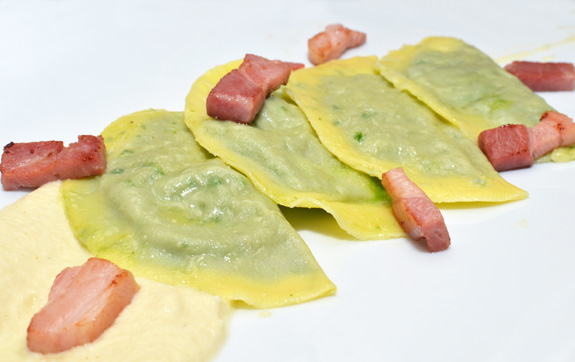I’ve already posted a couple recipes for varenyky here and here, so I figured I’d come up with a third one — and write an entry with everything you’ll ever want to know about these Ukrainian ravioli.

Picture courtesy of Fracture
But first, is it varenyky or vareniki? Well, it depends. The Russian word, вареники, should be transliterated as vareniki. But since this is in fact a Ukrainian dish, it makes sense to transliterate the Ukrainian word instead. And the Ukrainian word is… вареники. Even if you can’t read Cyrillic, you probably noticed the two are spelled the same. But they’re not pronounced the same. The Ukrainian и is similar to the Russian ы, hence the transliteration with y’s. Big deal.
Next, is it varenyky or pierogi? (I’m not even going to talk about the different spellings of pierogi!) Pierogi is a Polish word, but other than that, the difference is tenuous. A dumpling is a dumpling. Varenyky are typically boiled, and pierogi tend to be boiled, and then baked or fried. But I’ve eaten both fried varenyky and simply boiled pierogi.
As for the filling, almost anything goes. Technika Publishers’ Ukrainian Cuisine, a Soviet gem from 1975, lists no less than 19 variations, with cottage cheese, meat, liver and salt pork, heart and lungs, potato, potato and mushrooms, sauerkraut, cabbage and mushrooms, beans and mushrooms, mushrooms, fish, strawberries, cherries, apples, plums, prunes, poppy seeds, and then some with buckwheat flour.
Today, we’ll focus on savory recipes, with the two versions I’ve already published, plus a brand new “cabbage” rendition that has the particularity of containing no cabbage per se — as I keep saying, bok choy and Brussels sprouts both belong to the cabbage family, and I find them much more interesting to cook with and to eat than a big greenish head of plain cabbage. I’ll first give the dough preparation and varenyky assembly instructions, and then the filling recipes.
And finally, no post about varenyky would be complete without mentioning the several monuments erected to their glory, such as the outstanding piece of art in the above picture, from Glendon, Alberta.
Pasta dough
Yields slightly over 24 varenyky
6 oz flour (sometimes slightly more, see below)
1/4 tsp salt
1 1/2 eggs
2 egg yolks
1 tbsp olive oil
- In the bowl of an electric mixer fit with the paddle attachment, place half of the flour, plus the salt, egg, egg yolks and olive oil. Mix over low speed until homogeneous, scraping down the sides with a spatula. Add the rest of the flour and mix again until it forms a smooth paste.
- Transfer to a floured surface, and knead with your hands for about 3 minutes. If necessary, add a little bit more flour until the dough doesn’t stick. Wrap in plastic and let rest for 30 minutes.

Figures from Festive Ukrainian Cooking
Assembling the varenyky
Yields about 6 servings (24 varenyky)
pasta dough
1 egg yolk
1 tbsp water
filling (about 16 oz, see individual recipes)
semolina
salt
1 oz butter
- Using a pasta machine, roll the dough to the finest setting. I recommend proceeding in batches (cut the dough into 4 pieces) so that the pasta doesn’t dry out. Mix the egg yolk and water to make an egg wash.
- Cut 24 discs (6 discs in each batch) using a 3 1/2″ cutter. Brush each disc with the egg wash, place a spoonful of filling in the center, then fold into half-moon shapes and seal the edges with your fingers. Each one should have a generous amount of filling, but not so much that it’s difficult to seal properly. Keep the varenyky on a sheet tray dusted with semolina.
- Cook the varenyky in a large pot of boiling salted water until soft. Drain, toss into a bowl with the butter, and serve immediately.
Potato purée filling
Yields about 6 servings (24 varenyky)
8 oz peeled Yukon Gold potatoes, cut into 1″ slices
salt
1 oz sour cream
2.5 oz butter
1 pinch black pepper
1 pinch ground nutmeg
- Bring a pot of unsalted water to 175 F. Add the potatoes, and cook for 30 minutes, maintaining the water temperature at 160 F (if you use a lot of water and cover the pot with a lid, the temperature should remain almost constant without you doing anything). Transfer the potatoes to a bowl of ice water, and let cool completely.
- Bring the pot of water up to a boil and salt the water. Add the potatoes and simmer until cooked.
- Pass through a food mill fit with the finest disk; if necessary, use some of the sour cream to get the grinding going. Mix the potatoes with the sour cream, butter, black pepper and nutmeg, then push the mixture through a sieve — you can either pass it through a conical sieve with a ladle, or rub it through a drum sieve with a spatula. Transfer to a plastic container, and refrigerate.
Butternut squash filling
Yields about 6 servings (24 varenyky)
1 small butternut squash (about 1.5 lb)
6 oz peeled onion, brunoise
2 oz butter
1/4 tsp ground star anise
1/4 tsp Urfa pepper
1 tsp honey
salt
- Poke the butternut squash in a few places with a knife (to prevent bursting), and bake in a 350 F oven for 1 1/2 hours. Let cool.
- Cut the squash in half, discard the skin and seeds, then measure 10 oz of flesh and mash it with a fork. Reserve the rest of the flesh for another recipe.
- In a saucepan over medium heat, sauté the onion in 2/3 of the butter until soft. Add the star anise and Urfa pepper, and cook for another minute, stirring constantly. Add the butternut squash, honey, and remaining butter, season with salt, and cook for 2-3 minutes, stirring constantly. Remove from the heat and let cool.
“Cabbage” filling
Yields about 6 servings (24 varenyky)
6.7 oz finely sliced Brussels sprouts
1.3 oz olive oil
salt
black pepper, ground
2.7 oz bok choy leaves
1.3 oz baby spinach leaves
1.3 oz butter
water (see below)
- In a pan over medium heat, sauté the Brussels sprouts in the olive oil, season with salt and pepper, then cover with a lid and cook until soft, stirring regularly. Let cool and reserve.
- Blanch the bok choy leaves in boiling salted water, drain well, and reserve. Repeat with the spinach leaves.
- Process the bok choy, spinach, and half of the Brussels sprouts with the butter in a food processor (or a powerful blender) until smooth. If the mixture is still too thick and chunky, add a little bit of water and blend again. The amount of water you need depends on how much you drained the boiled greens.
- Mix in the rest of the Brussels sprouts, and refrigerate.
- Serve the “cabbage” varenyky with the sauerkraut cream below, and 6 oz of sautéed pancetta. You can sprinkle about 2 tsp of chopped chives on top of the dumplings, or, like I did in the pictures, add the chives directly into the dough when you start rolling it in the pasta machine.
Sauerkraut Cream
Yields about 6 servings
6 oz very well drained sauerkraut with caraway seeds
6 oz heavy cream
2 oz vegetable or chicken stock
- Note: I found this nice caraway sauerkraut from Hawthorne Valley Farm at the Union Square Greenmarket, but you can buy any good plain sauerkraut and add about 1/4 tsp caraway seeds.
- Coarsely chop the sauerkraut, then place into a saucepan with the heavy cream. Bring to a boil, then remove from heat.
- Transfer to a blender, add the stock, and whiz until smooth. Pass through a chinois and reserve.
- Reheat before serving.



7 comments
I love your 3 cabbage vareniki. Sauerkraut cream sounds like a fun idea. That definitely puts this dish into “contemporary Russian” category. Your blog made me think about what makes a dish feel contemporary. The use of a high speed blender seems to be a recurring trend 🙂 By the way, I exchanged my blendtec for vitamix. Can’t figure out which one I like more yet. Blackberries are still problematic.
The use of a blender and a chinois is definitely a factor. I would add changes in cooking methods (cooking proteins more slowly to lower internal temperatures), dishes made of many elements plated together, and the use of new or forgotten ingredients.
Bah! My Grandmother, Great-Grandmother, and Great-Aunt would throw a fit if you told them that pierogi and varenyky are the same, at least here in the US! The Polish take tends to not only be prepared fried more often than not (as you note), but also tends to be made with a thicker, doughier shell with a more defined edge (which, among other things, does help them hold together better for frying & sauteeing). Ukrainian varenyky tend to be very thin-skinned (even bordering on translucent with darker fillings such as buckwheat) with a bigger filling-dough ratio, and a finer edge holding it together. I’ll never forget some of the fantastic Varenyky I had during my trip to western Ukraine… some of the cafes in Lviv elevated them to haute cuisine that could stand up against any dumpling on earth!
Hello, I think your blog might be having browser compatibility issues.
When I look at your blog in Opera, it looks
fine but when opening in Internet Explorer, it
has some overlapping. I just wanted to give you a quick
heads up! Other then that, excellent blog!
Thanks. I’m not sure I can do anything about it though, the layout is entirely managed by wordpress.com…
Simply brilliant 🙂
[…] from my days at Danube to create fried varenyky. I’ve already dedicated an entire post to varenyky, so this is another variation to add to that repertoire. On the other hand, leeks, though […]